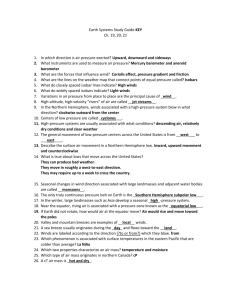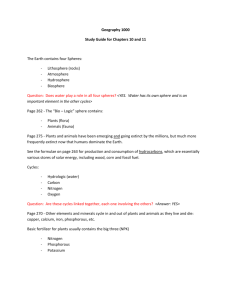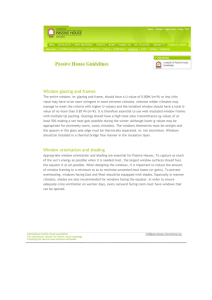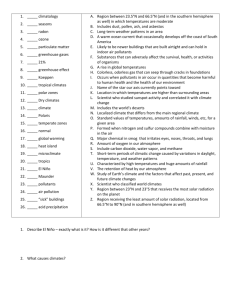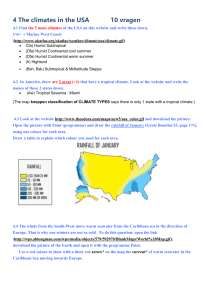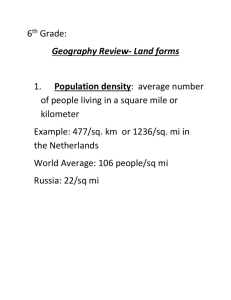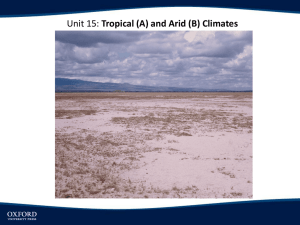chapter 10 tropical and southern hemisphere climates
advertisement
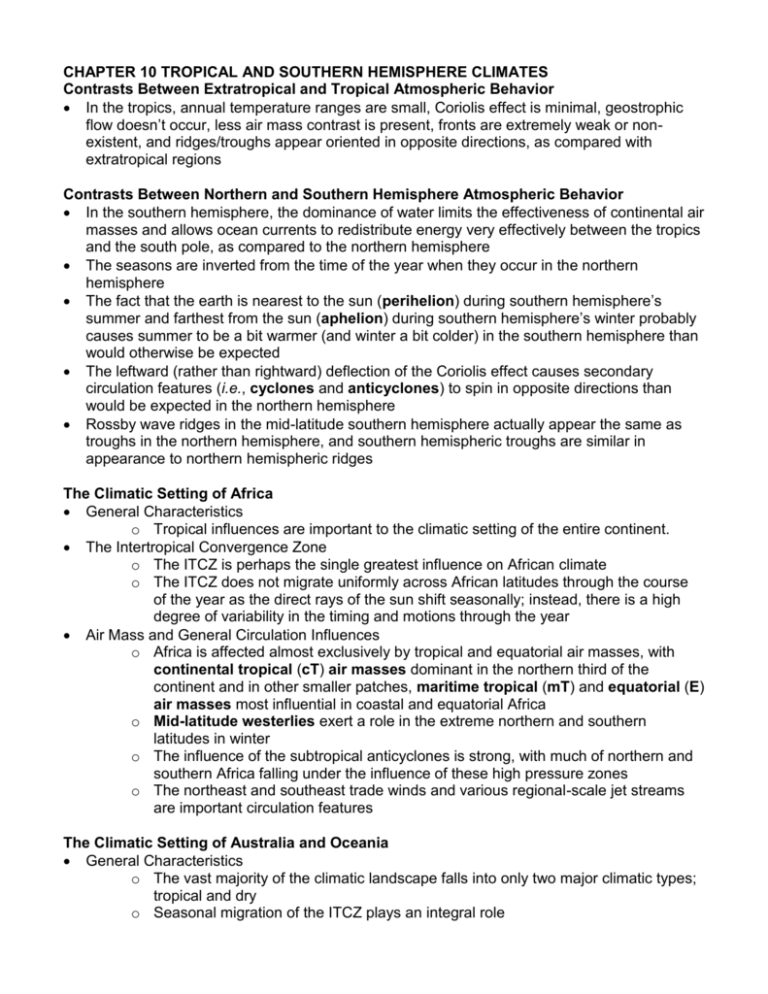
CHAPTER 10 TROPICAL AND SOUTHERN HEMISPHERE CLIMATES Contrasts Between Extratropical and Tropical Atmospheric Behavior In the tropics, annual temperature ranges are small, Coriolis effect is minimal, geostrophic flow doesn’t occur, less air mass contrast is present, fronts are extremely weak or nonexistent, and ridges/troughs appear oriented in opposite directions, as compared with extratropical regions Contrasts Between Northern and Southern Hemisphere Atmospheric Behavior In the southern hemisphere, the dominance of water limits the effectiveness of continental air masses and allows ocean currents to redistribute energy very effectively between the tropics and the south pole, as compared to the northern hemisphere The seasons are inverted from the time of the year when they occur in the northern hemisphere The fact that the earth is nearest to the sun (perihelion) during southern hemisphere’s summer and farthest from the sun (aphelion) during southern hemisphere’s winter probably causes summer to be a bit warmer (and winter a bit colder) in the southern hemisphere than would otherwise be expected The leftward (rather than rightward) deflection of the Coriolis effect causes secondary circulation features (i.e., cyclones and anticyclones) to spin in opposite directions than would be expected in the northern hemisphere Rossby wave ridges in the mid-latitude southern hemisphere actually appear the same as troughs in the northern hemisphere, and southern hemispheric troughs are similar in appearance to northern hemispheric ridges The Climatic Setting of Africa General Characteristics o Tropical influences are important to the climatic setting of the entire continent. The Intertropical Convergence Zone o The ITCZ is perhaps the single greatest influence on African climate o The ITCZ does not migrate uniformly across African latitudes through the course of the year as the direct rays of the sun shift seasonally; instead, there is a high degree of variability in the timing and motions through the year Air Mass and General Circulation Influences o Africa is affected almost exclusively by tropical and equatorial air masses, with continental tropical (cT) air masses dominant in the northern third of the continent and in other smaller patches, maritime tropical (mT) and equatorial (E) air masses most influential in coastal and equatorial Africa o Mid-latitude westerlies exert a role in the extreme northern and southern latitudes in winter o The influence of the subtropical anticyclones is strong, with much of northern and southern Africa falling under the influence of these high pressure zones o The northeast and southeast trade winds and various regional-scale jet streams are important circulation features The Climatic Setting of Australia and Oceania General Characteristics o The vast majority of the climatic landscape falls into only two major climatic types; tropical and dry o Seasonal migration of the ITCZ plays an integral role El Niño/Southern Oscillation Influences o The greatest single cause of climatic variability in this region is the El Niño/Southern Oscillation (ENSO) phenomenon o Approximately every 3 – 7 years, a warm-ENSO event occurs in association with a massive reduction in the strength of the trade wind flow, and a massive quantity of warm water migrates eastward across the equatorial Pacific in autumn o During La Niña events, a strengthening of the “normal” atmospheric and oceanic circulation conditions occurs, with the normally-wet areas of northern Australia and virtually all of Oceania becoming even wetter as regions in the eastern Pacific become even drier The South Pacific Convergence Zone o The SPCZ is an offshoot of the ITCZ, generally oriented in a northwest-southeast alignment or perhaps a north-south alignment, and is most active during the summer months when surface heating is maximized o Forms as a convergence zone between the South Pacific high and the frequent anticyclones that tend to remain in place over or near Australia o The SPCZ itself may fluctuate in orientation from northwest-southeast to northsouth, with the northern part acting almost as a “hinge” with more “swinging” on the southern side o Position affects moisture regime in eastern Oceania and region of formation of tropical cyclones The Madden-Julian Oscillation o Often referred to as the 30–60 Day Oscillation, or the 40–50 Day Oscillation because of the time scales on which it generally operates, with some variability present in the timing of the oscillation o MJO involves variations of upper- and lower-level winds, sea surface temperatures (SSTs), and associated cloudiness and precipitation o The MJO is associated with eastward-propagating outgoing longwave radiation anomalies across the tropical Pacific Ocean o Associated with variability in convective thunderstorm development for particular regions The Quasi-biennial Oscillation o Stratospheric winds above the equator oscillate in direction between the Berson easterlies and the Krakatau westerlies, with a period of about 26 months o Linked to the mixing of gases, including ozone, throughout the otherwise-stagnant stratosphere; combines with ENSO to influence east Asian monsoon precipitation, linked to Sahelian precipitation and tropical cyclone variability The Climatic Setting of Latin America General o Of the mountain features, the Andes exert by far the most influence on climate o Effect of the cold ocean current off the west coast o Despite its interior location, the Amazon basin acts as a primary moisture source for a large segment of South America ENSO Contributions o The greatest source of climate variability is caused by El Niño and La Niña events o In warm-ENSO events, ecosystem balance is altered, and flooding and mudslides are commonplace throughout western South America o During La Niña events, anomalously dry conditions (even in environments that are normally dry) occur through the western regions, while very heavy afternoon rains prevail over Amazonia The Climatic Setting of Antarctica Affected by high latitudes, continentality, and very high elevations Precipitation varies appreciably between coastal locations and the interior Antarctica is extensively studied for its potential role in anthropogenic global warming Less than five percent of the continent is ice-free Regional Climates A—Tropical Climates o Tropical (A) climates occur throughout Southeast Asia, Indonesia, northern Australia, Oceania, Central Africa, Central America, the Caribbean Sea, and most of South America o Tropical Rain Forest (Af) and Tropical Monsoon (Am) climates dominate throughout most of the equatorial tropics and are characterized by hot, humid, and rainy conditions that persist year-round and a lack of seasonality o Tropical Monsoon (Am) climates are different from Tropical Rain Forest areas only in that they exhibit a short dry season on a climatological average, but because the soil moisture seldom becomes depleted, dense forest persists as in Af climates o In Am climates of Asia, a winter dry season is typical because of the effects of the Asian monsoon, but in other locations, this climate may be found where onshore flow regimes wax and wane seasonally along with the intensity of the subtropical anticyclones o Tropical Savanna (Aw) climates mark the regions poleward of Af and Am climatic types and are characterized by distinct wet high-sun and dry low-sun seasons of approximately equal length, and somewhat greater annual temperature ranges than other tropical climate types o Aw climates support grassland vegetation because the dry season is too severe and long to support forest B—Arid Climates o Very extensive B regions, especially in northern Africa, southern Africa, and Australia o Most of the True Desert (BW) climates covered in this chapter are classified as the Subtropical Desert (BWh) climate, due to the relatively low latitudes of the regions o Atacama Desert of South America is the driest desert on earth due to a combination of very cold ocean currents and the nearby Andes Mountains that limits the advection of warm and moist air masses originating in the Amazon basin through the western coastal plain of South America o The Steppe (BS) climates of the tropics and southern hemisphere are vast and exist poleward of the True Desert cores C—Mesothermal Climates o Humid Subtropical (Cfa) climates comprise a large percentage of the area of mesothermal climate regions of the southern hemisphere o Like their extratropical northern hemisphere counterparts, Cfa climates have hot summers and moderate winter temperatures, with adequate precipitation welldistributed throughout the year o Mediterranean (Csa and Csb) climates are found in coastal northwest Africa, the southern coast of Australia, the southwestern tip of southern Africa, and central Chile west of the Andes o Marine West Coast (Cfb) warm summer climates are found poleward of Cfa climates o Cfb climates are found on the western coasts of mid-latitude Chile and Argentina, the southeastern coast of Australia, in virtually all of Tasmania and New Zealand, along a small sliver of southern Africa, and along scattered coastal (or near coastal) locations of southern Brazil and Argentina E—Polar Climates o Tundra (ET) climates of the southern hemisphere are limited to the Antarctic Peninsula extending from Ellsworth Land, Antarctica (which is in the western hemisphere, nearest to Tierra del Fuego), and on some of the ice-free islands surrounding Antarctica o Tundra ecosystems are surprisingly productive and the stability of the food chain in Tundra climates is of particular concern to many scientists as both phytoplankton and zooplankton are susceptible to excessive amounts of ultraviolet (UV) radiation o Ice Cap (EF) climates cover approximately 98 percent of Antarctica, and is characterized by extreme cold and dryness, and powerful katabatic winds H—Highland Climates o As mentioned in Chapter 9, highland climates are marked by vertical zonation in the climatic regimes along with radically variable climatic conditions across short spaces

